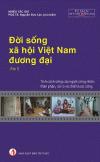
Nguyen Duc Loc (ed.)
Tri Thuc Press, 2015.
Reviewed by Nguyen Quang Dung
“The plight of laborers can be appraised through the lack of basic necessities like healthcare, daily meals, clothes, accommodation, education for their children and for themselves.” (page 123) This observation is the theme that runs through this book, unifying the collection of ethnographic analyses on factory workers from rural provinces, who strive for better lives in Southern Vietnam’s industrial zones. Through numerous interviews in factories, the volume offers close-up snapshots of the workforce population mainly in the industrial heartland of Binh Duong province. Government discourse portrays workers as the driving force behind the nation’s development. In reality, as the book describes, workers’ daily lives reflect poor economic conditions and a low social status. Phuc Nguyen’s study suggests that both married and single female workers migrated into industrial towns in order to fulfill duties towards their families: “They are living for the life of others.” (pp. 203) Troubling details about their malnutrition and cheap, contaminated food bought from local markets paint a bleak and hopeless picture for the blue-collar community, tugging at the readers’ heartstrings. Apart from the realities of work-life hardship, these workers have to face constant social prejudice from local people and factory owners alike. Job applicants from northern provinces are frequently rejected as they are believed to be aggressive and prone to protest. In various interviews, workers confess that they find it difficult to control their anger when it comes to conflicts with others or discontent with the treatment by their bosses (Cu Quang, pp.157-201).
One contributor provides a rich account of workers’ daily lives and goes on to note that many of the author’s interlocutors were preoccupied with the question whether “to stay or return”. Some interviewees were actively considering returning to their homeland, since their current working conditions rendered their hopes for a better life futile. Others seemed to have resigned themselves to their bitter fate. Another noteworthy chapter investigates the Pou Yen factory riot in 2013 to prove that the workers were not simply passive subjects of government policies. Instead, they responded vocally to a new social insurance law, which they perceived as unfair. Meanwhile, relevant authorities were not responsive to workers’ voices; especially the trade union, supposedly representing these people and defending their interests in welfare provision, actually failed completely to effectively fulfill its function. Based on this case study, the researchers recommend that more room should be given for dialogue among workers, factory owners and government representatives.
The book can serve as a useful reference for further research on workers’ protests and their connection to anti-China sentiment, nationalism, and daily hardship. It also is a call to stop worker exploitation. Workers’ grievances might have been one of the triggers of the 2014 riots in a country where most forms of subversion are suppressed. It prompted analysts to rethink Vietnam as a stable manufacturing environment, since the workforce struggles for their well-being on a daily basis. The authors’ treatment of relevant theories and concepts, as well as their references to other Asian societies –Korea and China- make this book an intellectually stimulating read. The chapters offer an abundance of quotes from interviews with workers. They would have benefited from more description of daily routines and from putting the stories in a social context. By providing more detail on workers’ daily interactions, the book would have been even better able to achieve its main purpose, namely to depict workers’ livelihood struggles and survival strategies (‘chien luoc song’).
